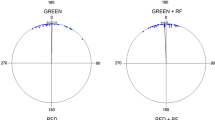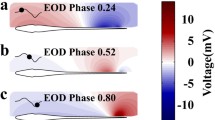Summary
Zygotes of the marine brown alga,Fucus serratus, have been subjected to the different modes of electric fields. 1) The result of a former study with conductive d.c. fields has been confirmed using electrostatic d.c. fields of 0.5 to 4 V/cm: the zygotes develop the cell polarity axis parallel to the imposed field with the rhizoid pole toward the cathode. 2) The frequency response to both, conductive and electrostatic, a.c. fields represents an optimum curve. The response,i.e. rhizoid formation at either or, in rare cases, both cell poles, peaks at square pulse durations,t E, of 70 to 120 ms. 3) The same frequency response appears if the pulse number is kept constant at 8s−1 by variation of the interval between the pulses,t o. Only fort oo > 200 ms,i.e. a pulse number of 3s−1 the response declines markedly. The data support our hypothesis that imposed electric fields induce cell polarityvia differential shift of the membrane potential rather than transcellular current flow. Furthermore, the given dose-response curves strikingly resemble those due to the other morphogenetically active signals: percent response consistently approximates the per cent signal intensity gradient which evokes it.
Similar content being viewed by others
References
Bentrup, F. W.: Vergleichende Untersuchungen zur Polaritätsinduktion durch das Licht an derEqnisetum-syore und derFucuszygote. Planta59, 472–491 (1963).
Bentrup, F. W.: (1) Die Morphogenese pflanzlicher Zellen im elektrischen Feld. Z. Pflanzenphysiol.59, 303–339 (1968).
Bentrup, F. W.: (2) Zur Funktion der Zellmembran bei der Cytomorphogenese. Ber. deut. botan. Ges.81, 311–314 (1968).
Bentrup, F. W.: Elektrophysiologische Untersuchungen am Ei vonFucus serratus: Das Membranpotential. Planta94, 319–332 (1970).
Bentrup, F. W.: Ion permeability changes of theFucus egg. Proc. I. Europ. Biophys. Congr. (Baden/Vienna)3, 69–73 (1971).
Bentrup, F. W., Sandan, T., Jaffe, L. F.: Induction of polarity inFucus eggs by potassium ion gradients. Protoplasma64, 254–266 (1967).
Bentrup, F. W., Jaffe, L. F.: Analyzing the group effect: Rheotropic responses of developingFucus eggs. Protoplasma65, 25–35 (1968).
Cole, K. S.: Membranes, ions and impulses. Berkeley: Univ. California Press 1968.
Cone, R. A.: Rotational diffusion of Rhodopsin in the visual receptor membrane. Nature New Biol.236, 39–43 (1972).
Feucht, U., Bentrup, F. W.: Über die photosensible Phase der Polaritätsinduktion beiEquiseptumaporen undFucuszygoten. Z. Pflanzenphysiol.66, 233–242 (1972).
Haupt, W.: Die Induktion der Polarität bei der Spore vonEquisetum. Planta49, 61–90 (1957).
Jaffe, L. F.: Tropistic responses of zygotes of theFucaceae to polarized light. Exptl. Cell Research15, 282–299 (1958).
Jaffe, L. F.: Electrical currents through the developingFucus egg. Proc. Natl. Acad. Sci. (U.S.)56, 1102–1109 (1966).
Jaffe, L. F.: Localization in the developingFucus egg and the general role of localizing currents. Advances Morphogen.7, 295–328 (1968).
Jaffe, L. F.: On the centripetal course of development, theFucus egg, and self-electrophoresis. Develop. Biol. Suppl.3, 83–111 (1969).
Jaffe, L. F., Etzold, H.: Orientation and locus of tropic photoreceptor molecules in spores ofBotrytis andOsmunda. J. Cell Biol.13, 13–31 (1962).
Lund, E. J.: Electrical control of organic polarity in the egg ofFucus. Botan. Gaz.76, 288–301 (1923).
Müller, D., Jaffe, L. F.: A quantitative study of cellular rheotropism. Biophys. J.5, 317–335 (1965).
Neumann, E., Katchalsky, A.: Hysteretic conformational changes in biopolymers induced by high electric fields. Proc. First Europ. Biophys. Congr. (Baden/Vienna)6, 91–95 (1971).
Novak, B.: An electrophysiological study on the spatial differentiation of plant cells. Ph. D. Thesis, Tübingen 1972.
Novak, B., Bentrup, F. W.: Induction ofFucus egg polarity by electric a.c. fields. Naturwissenschaften57, 549–550 (1970).
Novak, B., Bentrup, F. W.: An electrical study of regeneration inAcetabularia mediterranea. Planta108, 227–244 (1972).
Weisenseel, M. H., Jaffe, L. F.: Membrane potential and impedance of developing fucoid eggs. Develop. Biol.27, 4555–574 (1972).
Author information
Authors and Affiliations
Rights and permissions
About this article
Cite this article
Novák, B., Bentrup, F.W. Orientation ofFucus egg polarity by electric a. c. and d. c. fields. Biophysik 9, 253–260 (1973). https://doi.org/10.1007/BF01184690
Received:
Issue Date:
DOI: https://doi.org/10.1007/BF01184690




